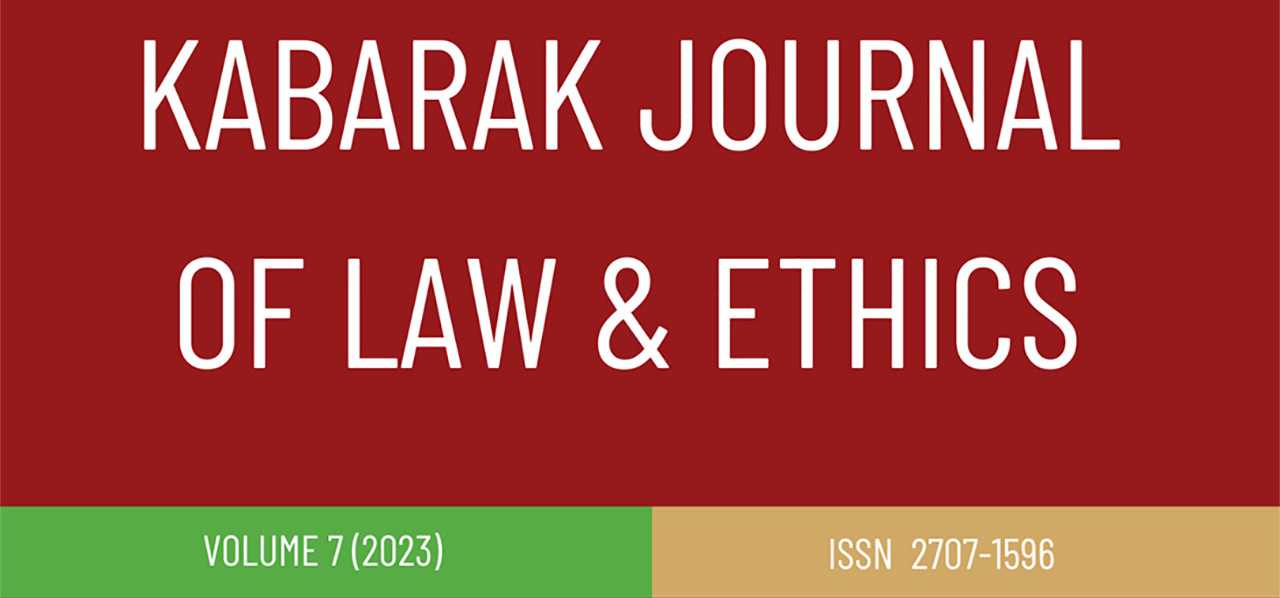The Kabarak Journal of Law & Ethics (KJLE) is the flagship publication of the Kabarak Law School (KLS). It is published by the Kabarak University Press (KABU Press). This will be the seventh volume of KJLE. KLS is pleased to invite submissions for its seventh issue [Volume (7) 2023] which is expected to be published in June 2023.
Background
The Kabarak Journal of Law & Ethics (KJLE) is the flagship publication of the Kabarak Law School (KLS). It is published by the Kabarak University Press (KABU Press). This will be the seventh volume of KJLE. KLS is pleased to invite submissions for its seventh issue [Volume (7) 2023] which is expected to be published in June 2023.
Scope of the Publication
We are inviting papers, book reviews and case discussions that will propose ground-breaking academic contributions to the discourse on governance and the rule of law in Africa. We invite submissions in two categories:
A. Focus on the Children Act 2022:
The Children Act (Act Number 29 of 2022) came into force on 26 July 2022. The enactment of the legislation was a culmination of a journey that began in 2005 after several gaps were identified in the now repealed Children Act 2001. The new law fortifies Article 53 of the Constitution of Kenya by elaborating in detail child rights, it makes provision for parental responsibility, provides for alternative care for children, guarantees protection of children in conflict with the law and establishes the institutional framework for promotion and protection of child rights in the country.
This issue will highlight the journey leading up to the enactment of the Children Act. Authors are invited to debate the need for the review of the Children Act 2001, unpack the various provisions in the law and debate whether the Act’s scope and vision for the best interests of the child is wholistic or has any glaring gaps or missteps. To this end, the editorial board lays out the following general thematic areas to guide authors in their contributions:
- Documentation of the journey towards the enactment of the Children Act, 2022.
- Highlights of the developments in the Children Act, 2022 and how it changes the landscape of child protection in Kenya.
- Analysis of the extent to which the new law aligns to the normative content of child rights at global and regional levels to wit: the Convention on the Rights of the Child and the African Charter on the Rights and Welfare of the Child.
- Comparative analysis of how the new Children Act compares to legislations developed by other jurisdictions.
B. Focus on the Education of the African Child
This year has also seen a lot of controversy over the education system adopted by Kenya- the Kenyan Competence Based Curriculum. To wit, the President appointed a 49 member Working Party on Education Reforms on 30 September 2022. There has also been quite some controversy around legal education in Kenya, including whether the format of education is appropriate for the production of legal professionals who are fit for market. Contestation on this has included issue of the appropriateness of having law as a first degree, allegations of anti-competitive administration of the Advocates Training Programme (ATP) and the controversies around having multiple regulators of academic institutions and their roles in accreditation of programmes. As such, the KJLE welcomes submissions that may concern the education of the African Child. This may include:
- The history, policy and politics of curriculum administration and review in Kenya.
- The legal controversies surrounding administration and accreditation of academic programmes in Kenya.
- The controversies around the adequacy of legal education in Kenya.
- Opportunities for legal reform in the education sector.
C. Case reviews and book commentaries
In our sixth volume, the KJLE established what it hopes will become a tradition to have a section dedicated to short pieces (not less than 3000 words) which highlight significant changes in the law. The editorial board welcomes any such pieces for our seventh edition. These pieces may include case reviews on landmark cases passed recently and any book reviews. These do not have to be on the sections that the issue is focussing on. However, in line with the focus on the Children Act, 2022, any case reviews or book commentaries that may highlight the work of the new Act are highly welcome.
Submission & Review guidelines
- Submissions must be original and not have already been published or submitted elsewhere.
- Articles should be note less than 8,000 words in length.
- Case commentaries and book reviews should be at least 3,000 words in length and include web links to cases cited.
- Authors should use UK English in preparing their papers.
- KJLE adopts the Kabarak University Legal Citation Guide (KALCI) and submissions should conform to it. If in doubt, an author should put all citations, including repeat citations in footnotes, in full as they appear on the publication or website. This can thereafter be adapted into KALCI.
- The KJLE is a forum for discourse. To assure ourselves and our readership of the highest standards of academic integrity, all papers accepted for review will be subjected to double blind peer review. The editors will therefore require compliance with the submission timelines indicated to facilitate an efficient peer review process.
- Abstracts for the papers should be sent to
This email address is being protected from spambots. You need JavaScript enabled to view it. with a copy toThis email address is being protected from spambots. You need JavaScript enabled to view it. by 10 November 2022. Abstracts should be a minimum of 300 words. - Submissions should be submitted to https://journals.kabarak.ac.ke/index.php/kjle/issue/view/30 by 19 January 2023.
Further guidelines:
Font
⮚ Font Type – Times New Roman.
⮚ Font size for the text – 12.
⮚Font size for quotations inside the text – 11 – no italics – less than 35 words (within the text without change of font) more than 35 words (whole quotation indented to the right with the font prescriptions above.
⮚ Font size for the footnotes – 10.
Spacing
⮚ Line spacing for the text – 1.5.
⮚ Line spacing for the footnotes – 1.0 – single spacing.
⮚ No space before and after paragraphs.
Headings and sub-headings:
Headings should be aligned at 0 cm, and the text indented at 0.5 cm as follows:
1. Introduction (bold; font 14 pitch)
1.1. Legal basis for judicial review (bold; font 12 pitch)
1.1.1. Pre-2010 position (bold; font 12 pitch)
Subsequent sub-headings: no numbering, use bold or italics:
Pre-2010 jurisprudence on provincial administration
Jurisdiction
Paragraph
⮚ Text alignment – Justified.



